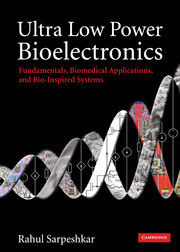Book contents
- Frontmatter
- Contents
- Acknowledgements
- Section I Foundations
- Section II Low-power analog and biomedical circuits
- 11 Low-power transimpedance amplifiers and photoreceptors
- 12 Low-power transconductance amplifiers and scaling laws for power in analog circuits
- 13 Low-power filters and resonators
- 14 Low-power current-mode circuits
- 15 Ultra-low-power and neuron-inspired analog-to-digital conversion for biomedical systems
- Section III Low-power RF and energy-harvesting circuits for biomedical systems
- Section IV Biomedical electronic systems
- Section V Principles for ultra-low-power analog and digital design
- Section VI Bio-inspired systems
- Section VII Energy sources
- Bibliography
- Index
- Epilogue
- References
13 - Low-power filters and resonators
from Section II - Low-power analog and biomedical circuits
Published online by Cambridge University Press: 02 December 2010
- Frontmatter
- Contents
- Acknowledgements
- Section I Foundations
- Section II Low-power analog and biomedical circuits
- 11 Low-power transimpedance amplifiers and photoreceptors
- 12 Low-power transconductance amplifiers and scaling laws for power in analog circuits
- 13 Low-power filters and resonators
- 14 Low-power current-mode circuits
- 15 Ultra-low-power and neuron-inspired analog-to-digital conversion for biomedical systems
- Section III Low-power RF and energy-harvesting circuits for biomedical systems
- Section IV Biomedical electronic systems
- Section V Principles for ultra-low-power analog and digital design
- Section VI Bio-inspired systems
- Section VII Energy sources
- Bibliography
- Index
- Epilogue
- References
Summary
The laws of nature are but the mathematical thoughts of God.
EuclidIn this chapter, we shall discuss techniques for the design of active transconductor-capacitor (Gm-C) filters, which are power efficient compared with several other topologies. We shall particularly focus on second-order systems and resonators, since they are a good vehicle for illustrating general issues in filter design and are ubiquitous in RF design. We shall present an intuitive –s2 plane geometry for understanding second-order and first-order systems that allow them to be analyzed quickly without significant algebra and then generalize these methods to higher-order systems. Since cascades of first-order and/or second-order systems or summed first-order and/or second-order systems can architect all linear systems, such methods are useful in filter design, feedback system design, and all linear systems.
Filters have been built with various topologies. Five kinds include passive-RLC filters, op-amp-RC, Gm-C, MOSFET-C, and switched-capacitor filters. Passive-RLC filters are the most power efficient since the use of only passive components results in no power dissipation apart from that required to supply signal currents; these filters use only bidirectional components. Inductors above 100 nH, capacitors above 100 pF, and resistors above 10 MΩ are rarely practical in integrated-circuit design due to their large size. On-chip inductors and resistors are subject to significant parasitics that degrade their operation. For example, resistors often have significant distributed parasitic capacitance, and inductors frequently have significant resistance and parasitic capacitance. Passive components cannot be electronically tuned.
- Type
- Chapter
- Information
- Ultra Low Power BioelectronicsFundamentals, Biomedical Applications, and Bio-Inspired Systems, pp. 330 - 353Publisher: Cambridge University PressPrint publication year: 2010



